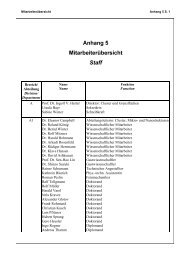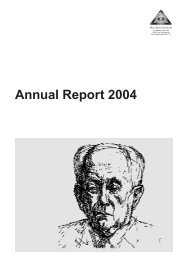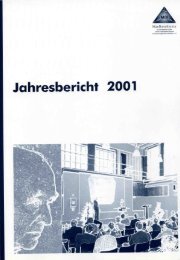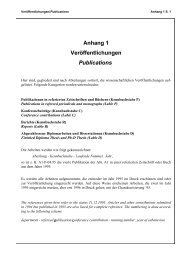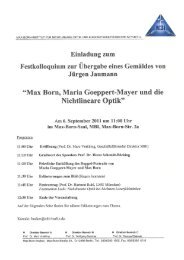Create successful ePaper yourself
Turn your PDF publications into a flip-book with our unique Google optimized e-Paper software.
34<br />
Fig. 1<br />
A group of portraits from the<br />
walls of G. Herzberg’s office.<br />
From left to right: James Franck,<br />
<strong>Max</strong> <strong>Born</strong>, Paul Dirac and <strong>Max</strong><br />
von Laue.<br />
Extending <strong>Born</strong>’s legacy<br />
into the 21 century:<br />
Inspired by movies of horses<br />
and waves:<br />
Fig. 2<br />
Series of photos taken by<br />
Eadward Muyerbridge in the<br />
1870’s. This was the scientific<br />
forefront of ultrafast measurement<br />
at the time these images<br />
were taken.<br />
<strong>Max</strong> <strong>Born</strong> • Paul Corkum<br />
and <strong>Max</strong> <strong>Born</strong>. Herzberg was a prolific letter writer. Not only did he write letters almost every<br />
night, but he also kept copies of everything he wrote. When he immigrated to Canada he even<br />
brought copies of letters he had written in Germany. In a wonderful biography [1] written about<br />
Herzberg’s life, Boris Stoicheff, his biographer, former student and co-worker, quotes from a letter<br />
written by Herzberg to <strong>Born</strong> or Franck (Stoicheff does not specify to whom it was addressed).<br />
In this letter, Herzberg thanks <strong>Born</strong> and Franck for their great help to him as follows:<br />
“Thank you for friendly guidance, not only in Physics but particularly in the proper attitude of<br />
a scientist to his work”.<br />
I wonder to what he was referring?<br />
I like to take students to Herzberg’s office to inspire them. I think that these great men become<br />
more real to the students when they stand in the office where Herzberg stood and look<br />
at the portraits as Herzberg would have seen them. I hope that they feel the weight of responsibility<br />
to make their own contribution to science. Through these links – the scientific approach<br />
assimilated in Goettingen, Herzberg’s contributions to quantum mechanics and the inspiration<br />
found in Herzberg’s office – the line extends from <strong>Max</strong> <strong>Born</strong> to Ottawa, even though, to my<br />
knowledge, he never visited.<br />
The line connecting <strong>Max</strong> <strong>Born</strong> to Ottawa is also intellectual. My research speciality is laser science.<br />
It combines both quantum mechanics and optics. <strong>Max</strong> <strong>Born</strong> made important contributions<br />
to both subjects.<br />
My essay is included in this volume because the specific scientific advance that I will describe has<br />
even stronger connections with <strong>Max</strong> <strong>Born</strong>. <strong>Max</strong> <strong>Born</strong> showed scientists how to think about the<br />
wave function and what measurements were possible. My group uses his insight. We split an<br />
electron wave function into two parts. Then we use one part of the wave function to measure the<br />
other. In this way we image a molecule’s electron, also building on the Herzberg legacy.<br />
Let me start with our dream. In the late 19th century, Eadweard Muybridge developed photographic<br />
techniques for measuring the fastest motion of his time – people moving, horses galloping<br />
or trotting. The technology enabled him to obtain striking images [2] of motion such as<br />
the one in Fig. 2. I think that it is a beautiful image. In four consecutive frames we can see the<br />
motion of a horse pulling a buggy. This was the forefront of ultrafast science in the 1870’s.



